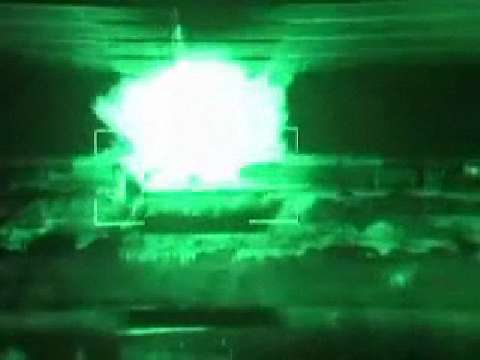Operation Sunburn: Difference between revisions
ContraViper (talk | contribs) (Created page with "{{Template:WIP}}{{Infobox Military Conflict | conflict = Lolloh-Roul War | partof = | image = File:Inyur...") |
ContraViper (talk | contribs) |
||
| Line 38: | Line 38: | ||
==Background== | ==Background== | ||
==Assualt== | ==Assualt== | ||
The operation took place at six different sites across northern & central Lolloh. Helicopters landed a total of six Groupe de Gréva Alfa (GGA) - also known as Strike Team Alpha in English - while the Aéroforça sent a bomber force over the ocean to bypass Lollohian air defenses concentrated in the south. The commandos used laser-targeting devices to guide in laser-guided bombs onto road-mobile launchers and the underground facilities which held them. | |||
Lollohian forces counter-attacked the commandos to allow the trucks to escape - which forced the bombers to rely on their own less-reliable targeting systems. Three additional GGA teams were deployed via helicopter near the eastern roadways exiting the nuclear compounds and engaged a number of road-mobile launchers which had survived the bombings with small arms and man-deployed rockets. | |||
==Return Home== | ==Return Home== | ||
Revision as of 11:01, 17 February 2022
This article is incomplete because it is pending further input from participants, or it is a work-in-progress by one author. Please comment on this article's talk page to share your input, comments and questions. Note: To contribute to this article, you may need to seek help from the author(s) of this page. |
| Lolloh-Roul War | |||||||||
|---|---|---|---|---|---|---|---|---|---|
| |||||||||
| Belligerents | |||||||||
|
| Template:Country data Lolloh | ||||||||
| Commanders and leaders | |||||||||
|
| N/A | ||||||||
| Strength | |||||||||
|
x9 UGA Teams (~72 commandos, x9 UH-60 Helicopters) |
>600 soldiers | ||||||||
| Casualties and losses | |||||||||
|
|
Lolloh | ||||||||
Background
Assualt
The operation took place at six different sites across northern & central Lolloh. Helicopters landed a total of six Groupe de Gréva Alfa (GGA) - also known as Strike Team Alpha in English - while the Aéroforça sent a bomber force over the ocean to bypass Lollohian air defenses concentrated in the south. The commandos used laser-targeting devices to guide in laser-guided bombs onto road-mobile launchers and the underground facilities which held them.
Lollohian forces counter-attacked the commandos to allow the trucks to escape - which forced the bombers to rely on their own less-reliable targeting systems. Three additional GGA teams were deployed via helicopter near the eastern roadways exiting the nuclear compounds and engaged a number of road-mobile launchers which had survived the bombings with small arms and man-deployed rockets.
Return Home
Five of the six initial UGA teams were forced to fall back under heavy fire, and the UH-60's were forced to chose landing zones from 300-2600m behind the primary insertion points. Because the helicopters were flying nap-of-the-earth, they were not subject to the harassment by Lollohian SAM's that the aircraft were.
Aftermath
In the immediate aftermath, both sides were quick to publicize the assault as a victory. The Inyurstans claim that destroying around two-thirds of Lolloh's nuclear stockpile was a major win, in addition to being capable of performing both insertions and air-raids deep into Lollohian territory. The Lollohians claimed that they had successfully managed to save enough nukes and that the Inyurstan attacks were a frivolous loss of life with no bearing on the direction of the conflict.
At the end of the war, Lolloh was pressured into surrendering its remaining nuclear stockpile under the Treaty of Quevril. Insiders claim the Lollohian transitional leadership briefly entertained the idea of threatening use of their nukes to scare the coalition into letting them keep their WMD stockpiles; however, this was quickly abandoned due to the risk of Semi-Mutually Assured Destruction (S-MAD).
A number of people, including defecting Lollohian scientists, Inyurstan and Mericki intelligence operatives, and even private military contractors claim that Lolloh did not surrender all of its nuclear material. It is also believed by some in the intelligence community that Lolloh later tried to solicit certain Shiite powers in the Middle East to obtain new warheads. These theories are corroborated by the fact that Lolloh did successfully obtain or retain a small number of Mass-Molten Copper (MMC) warheads in violation of the treaty - which they later attempted to use to cause massive Ruol civilian casualties.
